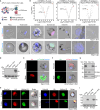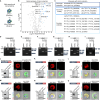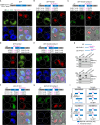An axonemal intron splicing program sustains Plasmodium male development
- PMID: 38824128
- PMCID: PMC11144265
- DOI: 10.1038/s41467-024-49002-9
An axonemal intron splicing program sustains Plasmodium male development
Abstract
Differentiation of male gametocytes into flagellated fertile male gametes relies on the assembly of axoneme, a major component of male development for mosquito transmission of the malaria parasite. RNA-binding protein (RBP)-mediated post-transcriptional regulation of mRNA plays important roles in eukaryotic sexual development, including the development of female Plasmodium. However, the role of RBP in defining the Plasmodium male transcriptome and its function in male gametogenesis remains incompletely understood. Here, we performed genome-wide screening for gender-specific RBPs and identified an undescribed male-specific RBP gene Rbpm1 in the Plasmodium. RBPm1 is localized in the nucleus of male gametocytes. RBPm1-deficient parasites fail to assemble the axoneme for male gametogenesis and thus mosquito transmission. RBPm1 interacts with the spliceosome E complex and regulates the splicing initiation of certain introns in a group of 26 axonemal genes. RBPm1 deficiency results in intron retention and protein loss of these axonemal genes. Intron deletion restores axonemal protein expression and partially rectifies axonemal defects in RBPm1-null gametocytes. Further splicing assays in both reporter and endogenous genes exhibit stringent recognition of the axonemal introns by RBPm1. The splicing activator RBPm1 and its target introns constitute an axonemal intron splicing program in the post-transcriptional regulation essential for Plasmodium male development.
© 2024. The Author(s).
Conflict of interest statement
The authors declare no competing interests.
Figures








Similar articles
-
Comparative proteomic analysis of kinesin-8B deficient Plasmodium berghei during gametogenesis.J Proteomics. 2021 Mar 30;236:104118. doi: 10.1016/j.jprot.2021.104118. Epub 2021 Jan 21. J Proteomics. 2021. PMID: 33486016
-
Vital role for Plasmodium berghei Kinesin8B in axoneme assembly during male gamete formation and mosquito transmission.Cell Microbiol. 2020 Mar;22(3):e13121. doi: 10.1111/cmi.13121. Epub 2019 Dec 12. Cell Microbiol. 2020. PMID: 31634979
-
A G-Protein-Coupled Receptor Modulates Gametogenesis via PKG-Mediated Signaling Cascade in Plasmodium berghei.Microbiol Spectr. 2022 Apr 27;10(2):e0015022. doi: 10.1128/spectrum.00150-22. Epub 2022 Apr 11. Microbiol Spectr. 2022. PMID: 35404079 Free PMC article.
-
Roles of minor spliceosome in intron recognition and the convergence with the better understood major spliceosome.Wiley Interdiscip Rev RNA. 2023 Jan;14(1):e1761. doi: 10.1002/wrna.1761. Epub 2022 Sep 2. Wiley Interdiscip Rev RNA. 2023. PMID: 36056453 Review.
-
Helicases involved in splicing from malaria parasite Plasmodium falciparum.Parasitol Int. 2011 Dec;60(4):335-40. doi: 10.1016/j.parint.2011.09.007. Epub 2011 Oct 1. Parasitol Int. 2011. PMID: 21996352 Review.
Cited by
-
Elevated NAD+ drives Sir2A-mediated GCβ deacetylation and OES localization for Plasmodium ookinete gliding and mosquito infection.Nat Commun. 2025 Mar 6;16(1):2259. doi: 10.1038/s41467-025-57517-y. Nat Commun. 2025. PMID: 40050296 Free PMC article.
References
-
- WHO. World Malaria Report 2019. (WHO, 2019).
MeSH terms
Substances
Grants and funding
LinkOut - more resources
Full Text Sources
Molecular Biology Databases

